




What Are the Different Types of Muscle Fibre?
We all perform day-to-day activities and sometimes we feel tired. Have you noticed when a kid or person of any age group runs or does some physical activity he feels tired? Also When we go to some adventurous place we feel tired, but why? Some people are strong and they do not feel tired soon on the other hand some people feel low. The answer to all questions is related to Muscles as some have strong muscles and they have a lot of energy to perform all the tasks in a day.
Our body is made up of bones and muscles! The human skeleton system has numerous different bones and muscles. Let’s understand muscle fibre in detail.
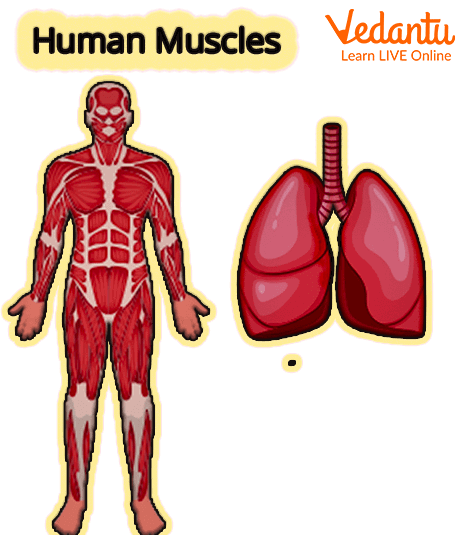
Human Muscles
What is Muscle Fibre?
Have you ever imagined what muscle fibre looks like? Let's have a look
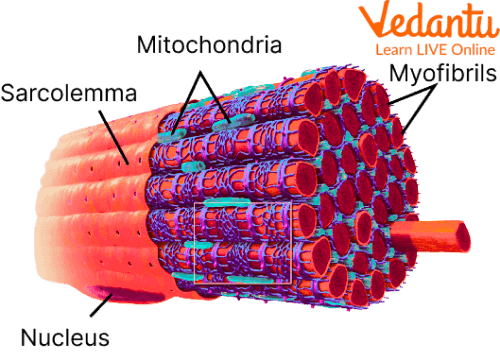
Muscle Fibre
Muscle fibres consist of a single muscle cell. They help to control the physical forces within the body. The Function of muscle fibres is to control the physical forces which are moving through the human body. A muscle fibre is composed of many long cylindrical-shaped fibres which are nearly 0.02 to 0.08 mm in diameter.
Types of Muscle Fibres
Now let's discuss the various types of skeletal muscle fibres.
There are mainly three types of muscle fibres namely:
1. Slow Oxidative (SO) Fibres:
These are the types of muscle fibres that contract slowly, they show slow contractions and use aerobic glucose and oxygen for producing ATP.
2. Fast Oxidative(FO) Fibres:
These are the type of muscle fibres that contract fastly and use aerobic respiration as well as anaerobic respiration. That is why they can get tired more quickly than the Slow oxidative fibres.
3. Fast Glycolytic (FG) Fibres:
These types of fibres have fast contractions and These fibres are slightly larger in diameter, they help in times of fatigue and help the body to be resistant towards fatigue.
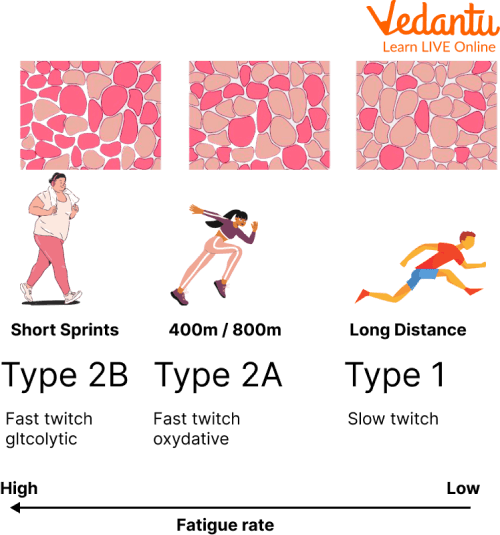
Different Types of Muscle Fibres
Structure of a Muscle Fibre
Each muscle fibre is a single cylindrical muscle cell. A single skeletal muscle can be made up of hundreds or even thousands of muscle fibres bundled together which are wrapped in a connective tissue covering.
Every muscle has a connective tissue sheath, which is called the epimysium.
Outside the epimysium, a connective tissue known as fascia is present which further separates the muscles.
Every bundle of muscle fibre known as a fasciculus has a layer of connective tissue known as the perimysium.
Location of a Muscle Fibre
Different types of muscle fibres are located in different parts of the human body.
The cardiac muscle fibres are located in the walls of the heart and are under involuntary control.
The smooth muscle fibres are located in organs like the intestines, pancreas, and liver and are also under involuntary control.
Skeletal muscle fibres are there in the muscles which are attached to the skeleton.
Diagram of a Muscle Fibre
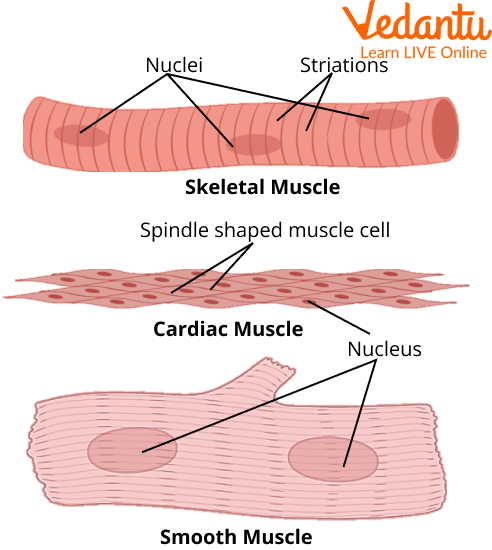
Diagram of a Muscle Fibre
Interesting Facts:
Do you know that it takes nearly the working of 17 muscles to act together to bring out the smile on our face?
The human body has nearly 600 muscles located in various parts of the body.
Muscles comprise nearly 40 percent of the human body weight.
Can you believe that one of the strongest muscles of the human body is located in our jaw.
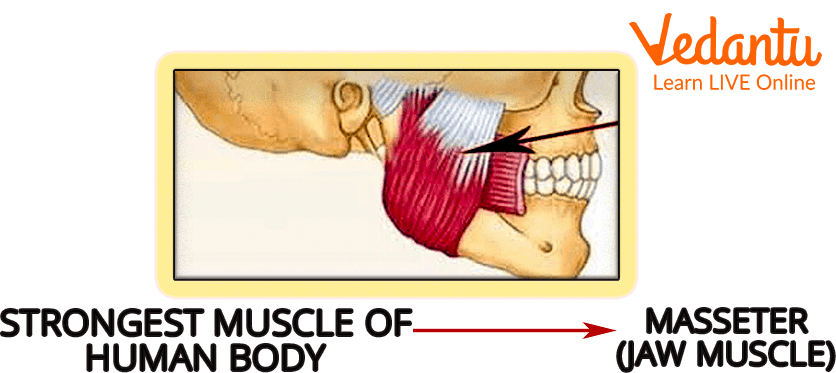
Jaw Muscle
The heart muscle is a muscle that works continuously in the human body.
The movement of our eyes takes place with the working of six muscle types.
The process of respiration and digestion in the human body is also aided by the muscles in the body.
Our muscles are built at the time when we sleep.
Summary
Thus we conclude that muscle fibres are very important . There are different types of muscle fibres located in the different parts of the human body and they play a vital role in the movement of the human body. Men have stronger muscles as compared to women. Different age groups have different stamina and as a person grows older the muscles get weak.
FAQs on Muscle Fibre: Key Concepts & Properties
1. What is a muscle fibre?
A muscle fibre is essentially a single, elongated, multinucleated muscle cell, also known as a myocyte. These fibres are the fundamental structural and functional units of a muscle. They are bundled together by connective tissue to form a complete muscle, and their collective contraction is what generates force and movement in the body.
2. What are the main components inside a muscle fibre?
A muscle fibre contains specialised cellular components essential for contraction. Key components include:
- Sarcolemma: The cell membrane of the muscle fibre that receives nerve signals.
- Sarcoplasm: The cytoplasm of the muscle fibre, rich in glycogen and myoglobin.
- Myofibrils: Rod-like organelles that run parallel to the length of the fibre. They are composed of myofilaments (actin and myosin) and are the actual contractile elements.
- Sarcoplasmic Reticulum: A specialised endoplasmic reticulum that stores and releases calcium ions to trigger contraction.
3. How does a muscle fibre contract to produce movement?
Muscle fibre contraction is explained by the sliding filament theory. When a nerve impulse reaches the fibre, it triggers the release of calcium ions. These ions allow the thick (myosin) and thin (actin) filaments within the myofibrils to bind and slide past one another. This sliding action shortens the entire myofibril and, consequently, the muscle fibre, resulting in a muscle contraction.
4. What are the main types of skeletal muscle fibres?
Skeletal muscles are composed of three main types of fibres, classified based on their speed of contraction and how they produce energy:
- Type I (Slow-Twitch Oxidative): Specialised for endurance activities.
- Type IIA (Fast-Twitch Oxidative-Glycolytic): A hybrid fibre that can use both aerobic and anaerobic metabolism.
- Type IIB/IIX (Fast-Twitch Glycolytic): Specialised for short, explosive bursts of power.
5. What is the functional difference between Type I (slow-twitch) and Type II (fast-twitch) muscle fibres?
The primary difference lies in their speed and endurance. Type I (slow-twitch) fibres contract slowly but are highly resistant to fatigue. They are rich in myoglobin and mitochondria, making them efficient at using oxygen for continuous energy, ideal for activities like marathon running. In contrast, Type II (fast-twitch) fibres contract rapidly and powerfully but fatigue quickly. They rely more on anaerobic metabolism for quick energy, making them crucial for activities like sprinting and weightlifting.
6. How does the composition of muscle fibres in a person relate to their athletic abilities?
The ratio of fast-twitch to slow-twitch fibres, which is largely genetically determined, can give an individual a natural advantage in certain sports. For example, an elite marathon runner might have a significantly higher proportion of Type I (slow-twitch) fibres in their leg muscles, providing superior endurance. Conversely, a world-class sprinter or powerlifter would likely have a dominance of Type II (fast-twitch) fibres, enabling greater explosive strength and speed.
7. Why is a muscle cell specifically called a 'fibre'?
A muscle cell is called a 'fibre' because of its distinct morphology. Unlike typical, roughly spherical cells, muscle cells are exceptionally long and slender, resembling a thread or fibre. This elongated structure is directly related to its function, as it allows the cell to contract along its length, pulling on its attachment points to create effective movement.
8. What is the difference between a muscle fibre and a myofibril?
This is a common point of confusion. A muscle fibre is the entire, complete muscle cell. A myofibril, on the other hand, is a smaller, sub-cellular component found in large numbers *inside* the muscle fibre. Think of the muscle fibre as a large cable, and the myofibrils as the many smaller wires bundled within that cable. The contraction of all the individual myofibrils leads to the contraction of the entire muscle fibre.









